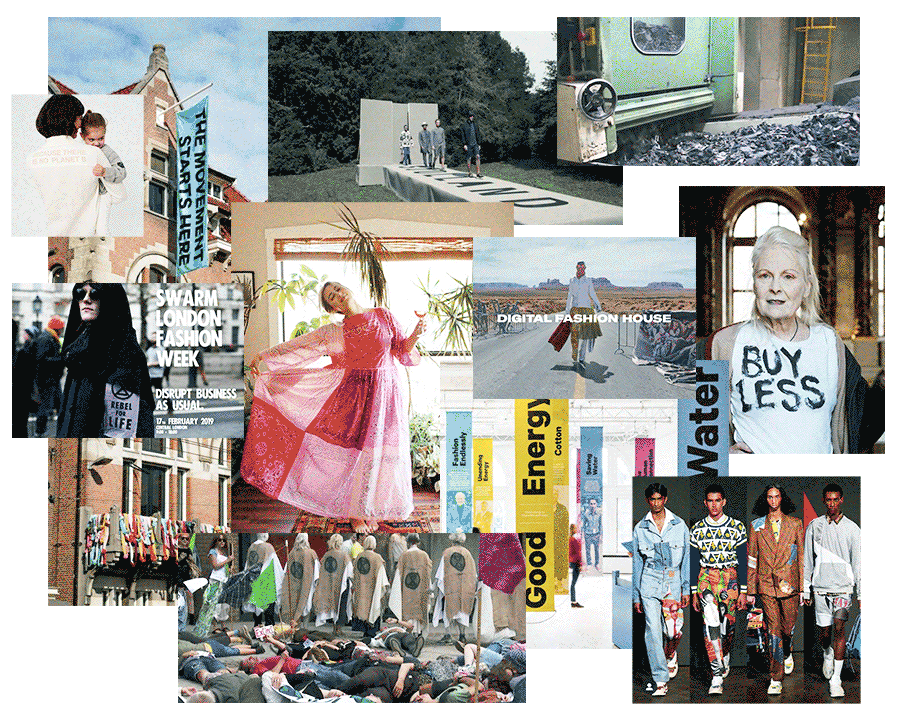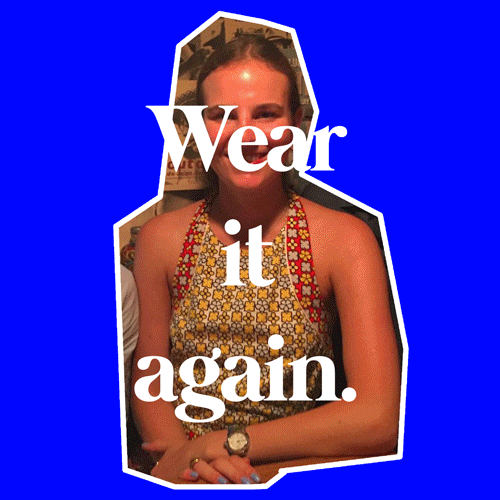I have intentionally not touched upon Covid-19 because the environmental impact and the solutions we need continue to be as relevant as ever. But it has been important for me to take this time during lockdown to reflect on the impact of this crisis we find ourselves in, and our place in it.
A ‘perfect storm’
As is the case for many sectors, this one has had to hit pause: pause on production, pause on shipping and in some cases even a pause on new design. The demand for clothing has slowed down to an unprecedented level and many brands are focusing on staying afloat.[1] Because of these challenges, there has never been such a ‘perfect storm’ to spur action and new systems thinking. It is a shame that, from a fashion sustainability perspective, I have never been more optimistic.
Crises bring opportunity and require creativity. Before this crisis, the fashion sector was not changing quickly enough. Yes, many brands had signed up to industry charters that commit them to reducing their emissions, restoring biodiversity and preserving the oceans,[2] but the translation from commitment to action has been limited to a minority of leading brands. On the other hand, some of the innovations, changes and discussions we have seen in the past 2 months are things I didn’t think we’d see for years to come.
On a macro level, this is ultimately a redesign challenge, and fashion at its core is about design. We have a decade to curb global emissions and this year will be key in shaping what this decade of action should look like. The micro level should instead focus on the design of garments. As people have been buying less, brands and their designers have been forced to think: what does the consumer actually want? Do they really want to blindly follow trends, or do they want to feel inspired and build a connection with a brand and its clothing?
Digitisation

Some of the changes we have seen so far include the planned consolidation of London Fashion Week’s men’s and women’s, which will now be online-only[3], with Milan and Paris following suit. This will be a fascinating example of a low-carbon fashion week and could open up a world of opportunities for digital buying.
Digital design is also on the rise. Designers are using software and 3D clothing sampling processes and virtual fit sessions.[4] This digitisation is much less carbon and waste intensive than producing samples, flying them across the world and having models present them in a showroom.
Slowing down
People are buying less. Fashion is not deemed an essential industry and production has in many cases come to a standstill. [5] Helpfully, many brands have switched their production to produce things we do desperately need: personal protective equipment. Consumers are connecting with their favourite brands on a basis other than simply shopping from them. Brands have signalled their values through their response to this equipment shortage and how they have dealt with the orders of clothes they’ve made but no longer need produced.[6]
Many sector experts predict that consumers will “become much more discerning with discretionary purchasing and their connection with brands will be important, as they ‘will want something meaningful’”.[7] Not only will consumers want to buy less, the recession caused by Covid-19 will also mean they won’t be able to spend as much after the pandemic.
And brands are taking note. For example, Saint Laurent has stated it won’t be showing a collection in Paris’ September Fashion week. The design house is looking to align the release of their collections more with when the customer is actually likely to buy it[8]. Similarly, Giorgio Armani announced that in order for the sector to regain and retain resilience it needs to slow down and realign collections with seasons in stores.[9] This is a glimmer of moving to designing and producing based on demand, rather than generating demand through supply.
What do we want this new world to look like?
When we return to the shops from lockdown, let’s not celebrate being outside by over consuming and buying outfits for our re-emergence into society. Instead, let’s celebrate the clothing we haven’t had the chance to wear during this time and relish in what we already have.
If we do feel inspired to buy something, let’s think carefully about what this item will bring to our wardrobe, how it makes us feel, interrogate how it was made and, if we do purchase it, cherish it fully. Let’s move from following trends to connecting emotionally with our clothing, its origins and the craft of its talented designers.
I love fashion – I always have. And ultimately that is why I love what I do. I love how clothes make me feel and how they can empower me to portray who I am and what I am feeling to the world. I would love for us to get to a place where we can buy an item of clothing without having to filter for sustainability or to trawl the Internet to find something we feel comfortable buying. I want to feel as morally comfortable buying a garment as I currently do physically wearing it.
The time is now for brands, producers, governments and consumers to think about the world they want to live in and how fashion fits into that. Clothing should not cost the Earth.

The views expressed in this article are the author’s own as an individual.
[1] https://www.voguebusiness.com/companies/fashion-industry-crisis-deepens-amid-covid-19-chaos [2] https://www.vogue.com/article/fashion-pact-sustainability-g7-summit-emmanuel-macron [3] https://i-d.vice.com/en_uk/article/akwbm8/london-fashion-week-is-going-gender-neutral-and-digital [4] https://www.forbes.com/sites/brookerobertsislam/2020/04/13/designer-and-supply-chain-digital-revolution-how-covid-19-is-changing-the-fashion-industry/#76cb6c107ccc [5] https://wwd.com/business-news/business-features/after-coronavirus-scenarios-for-apparel-design-sourcing-and-production-1203622397/ [6] https://www.vogue.com/article/paris-fashion-week-mens-july-2020 [7] https://www.forbes.com/sites/brookerobertsislam/2020/04/13/designer-and-supply-chain-digital-revolution-how-covid-19-is-changing-the-fashion-industry/#325ac3f87ccc [8] https://wwd.com/fashion-news/fashion-features/fashion-weeks-shifting-format-amid-coronavirus-1203565669/ Gif references:
Ecoalf (https://www.instagram.com/p/B_ua6stJdHS/) Extinction Rebellion LFW (https://sustainable-fashion.com/blog/fashion-x-extinction-rebellion/) The Fabricant ( https://www.thefabricant.com) Soulland Show (https://vimeo.com/72010790) Fabric Recycle (https://www.youtube.com/watch?v=AjHVMhAOZa4) Psychic Outlaw (https://www.psychicoutlaw.com/) Ahluwalia (https://www.ahluwaliastudio.com/) Fashion For Good Museum (https://fashionforgood.com/) Ectinction Rebellion Cornwall (https://www.youtube.com/watch?v=Gi-Ldj5uvtw)








